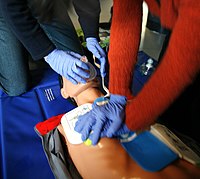
Photo from wikipedia
Background Pulseless electrical activity (PEA) is managed in accordance with international and national guidelines. These guidelines are not fully evidenced, resulting in emergency medical services in the United Kingdom amending… Click to show full abstract
Background Pulseless electrical activity (PEA) is managed in accordance with international and national guidelines. These guidelines are not fully evidenced, resulting in emergency medical services in the United Kingdom amending guidelines to support paramedics when making resuscitation decisions. This review examined the local guidelines of services to identify the local clinical management of PEA, summarise the available evidence and prioritise future research. Methods The review was conducted according to the Joanna Briggs Institute systematic review of text and opinion. The review included locally amended guidelines and cited evidence sources for the management of PEA. A three-step search strategy was applied. Textual data was extracted to form conclusions which were categorised into similar meaning and developed into synthesised findings. Results Twenty-two documents met the inclusion criteria; Twenty-seven conclusions were extracted and analysed to generate 10 categories, forming three synthesised themes: the variability in the clinical management of PEA between ambulance services; the early identification of reversible causes and appropriate treatment options to increase survivability; and the consensus for further research. Conclusion This review identified variability in the clinical management of PEA; the autonomy of paramedics, which patients to transport to hospital and the factors applied to inform resuscitation decisions. A summary of the evidence in support of the local guidelines found that the early identification and treatment to reverse the cause of PEA was important to patient survival, however, this was acknowledged as complex and challenging to achieve. There was a consensus to improve patient outcomes using prognostic research.
Journal Title: Australasian Journal of Paramedicine
Year Published: 2021
Link to full text (if available)
Share on Social Media: Sign Up to like & get
recommendations!